Inca Warfare › Jason & the Argonauts » Ancient origins
Articles and Definitions › Contents
- Inca Warfare › Ancient History
- Jason & the Argonauts › Antique Origins
Ancient civilizations › Historical and archaeological sites
Inca Warfare › Ancient History
Definition and Origins
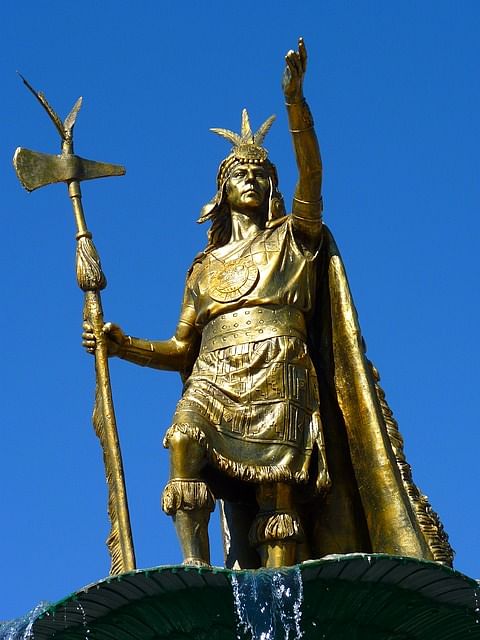
The warfare of the Inca civilization was characterised by a high degree of mobility, large-scale engagements of hand-to-hand combat, and the establishment of a network of fortresses to protect an empire of over 10 million subjects. Conquest gave the Incas access to vast new resources and gained prestige for both rulers and those warriors who displayed courage on the battlefield. Diplomacy was an important tool and used time and again by the Incas to acquire new territory with the minimum of bloodshed but sometimes they were obliged to engage in battle and several regions of the empire persistently resisted Incarule. Ultimately, though, only the arrival of the Europeans with their superior technology would stop the Inca rulers relentlessly expanding their empire.
EXPANDING THE EMPIRE
The Incas were great diplomats, and they were able to extend their influence throughout the Andes region by negotiating trade and tribute agreements, offering impressive gift exchanges, organising inter-marriages, and relocating sympathetic populations to newly acquired or troublesome areas. Only when these strategies failed did warfare become necessary. Early Inca warfarewas concerned merely with acquiring the wealth of the enemy but gradually, as they became more ambitious, they sought to permanently control the territory of their neighbours and so spread their influence across South America.
Conquest was important for a ruler's prestige, not only during his reign but also after his death when his deeds would be recounted and pilgrimages made to the sites of his great victories. Rulers naturally wanted to outdo their predecessors and so the empire expanded ever outwards into new territories throughout the history of the Incas.
CONQUEST WAS IMPORTANT FOR A RULER'S PRESTIGE, NOT ONLY DURING HIS REIGN BUT ALSO AFTER HIS DEATH WHEN HIS DEEDS WOULD BE RECOUNTED.
There was also a religious element to warfare as the Incas saw their conquests as furthering the worship of the sun god Inti.For this reason, campaigns were preceded by fasting for two days and then ceremonies of sacrifices (usually black llamas and sometimes children too) and feasting. Priests and religious idols accompanied the army on campaign, and certain religious events were respected even during battle. For example, on the new moon no fighting was permitted, a fact the Spanish took advantage of when they attacked Cuzco in the first half of the 16th century CE.
TROOPS & COMMAND STRUCTURE
The Inca army was largely composed of non-Incas, those conquered peoples who were obliged as a form of tribute to give their persons for use by their overlords. For this reason, the Inca army was a conglomerate of individual ethnic units, each led by their own local commander and fighting with their own preferred weapons. Speaking different languages, these units must have been difficult to coordinate in the heat of battle. In addition, these soldiers were in fact farmers and their effectiveness, or lack thereof, probably explains why the Incas eventually began to form a professional army. Units were divided into decimals, the smallest group being 10 men commanded by a chunka kamayuq, then 100 led by a pachaka kuraka, then 1,000 men under a waranqa kuraka, and finally 10,000 led by a hunu kuraka. Officers often commanded in pairs, although it is unclear how duties were divided between them.
Inca armies, then, consisted of tens of thousands of troops, perhaps even over 100,000 in some battles. Soldiers were called up from the general populace on a rotation basis with any male aged from their mid-twenties to their fifties eligible for active service. Soldiers could take their wives with them on campaign. Men under the age of 25 were expected to act as baggage carriers and joined an impressive entourage of non-combatants which included cooks and potters. Although the troops were farmers when not needed by the state all Inca males were given weapons training in their youth and performed in ritual battles.The pure-blood Incas formed an elite army of a few thousand; sometimes they were supplemented by choice picks from other units too. They acted as the personal bodyguard of the Inca king and wore distinctive tunics of black and white checks with a bright red triangle at the neck.
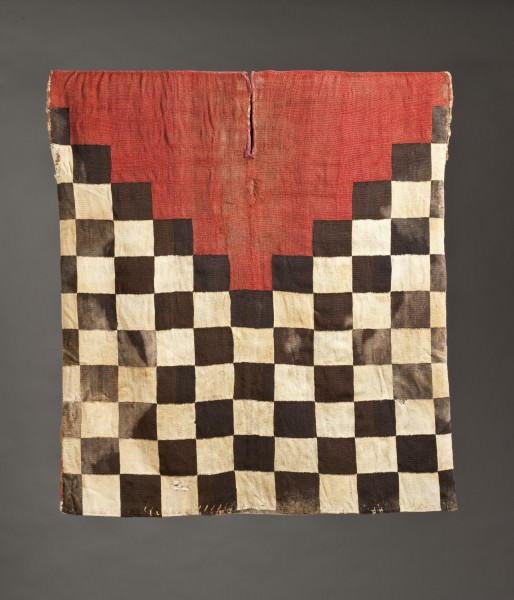
Inca Military Tunic
The senior army commanders were usually of royal blood. The Inca king was the commander-in-chief, and to avoid subsidiary commanders gaining too much prestige and making themselves a threat to his reign, he often commanded the army in the field personally. However, as the empire expanded, this became too impractical for the king to be so long-absent from the capital Cuzco, and the burden of command in the field often rested on the shoulders of his brother or son. Either way, field commanders rarely involved themselves in the front line, and it was more usual for them to issue general orders from the safe distance of a command post.
WEAPONS
Battles were bloody and confused episodes of hand-to-hand combat. Weapons differed depending on the ethnic origin of particular units but included hardwood spears launched using throwers, arrows, javelins, slings, the bolas, clubs, and maces with star-shaped heads made of copper or bronze. The favourite weapon seems to have been the palm-wood club which was shaped like a sword and had a double-edge. Large stones were also employed to roll down on the enemy and grass fires if the terrain was suitable. Protection was provided by hide rectangular or trapezoid shields, helmets of plaited cane or wood, and metal plates over the chest and back or tunics of quilted cloth which were both resistant and light to wear.
Besides weapons, troops were issued with a set of clothes, sandals, a blanket, and some foodstuffs such as maize, peppers, and coca leaves. Soldiers would put on their best finery for battle such as extravagant feather headdresses and burnished silver or copper breastplates. Soldiers might also wear decorations of their previous escapades such as necklaces made from the teeth of enemies and copper or silver medallions given as rewards by their commanders.

Inca General Ruminahui
STRATEGIES
The great strength of the Incas in warfare was not technological superiority or better fighting tactics than the enemy but their great preparedness and hitting the enemy with overwhelming numbers. Before battle, though, it was a common tactic to send messengers to the enemy offering favourable terms of surrender and promising rewards to the leaders who would be allowed to continue in their positions of power. Further, the community would not be robbed of all their resources as long as they pledged allegiance to the Inca king, accepted the Inca sun god Inti as the supreme deity, and offered regular tributes both in goods and labour. A huge area of the Upper Mantaro Valley was conquered in this way without any bloodshed whatsoever.
On the other hand, if the enemy insisted on battle, the Incas would mobilise their superior numbers, wipe out the opposing army without mercy, and deport as many of the conquered population as possible, effectively erasing the city from the archaeological record. Areas dealt with in this way included Tunanmarca, Canete, and the Cayambe people in Ecuador. Those areas, such as around Lake Titicaca, which repeatedly displayed rebellion were pacified from within by relocating Inca sympathetic populations to them.
On the battlefield actual engagements were preceded by both armies singing songs and hurling insults at each other, a process which could take several days. When the battle started proper, attacks were either front-on over open terrain or siege warfare. Spies were sent before the battle to ascertain the lie of the land, and the Inca army usually struck in a single mass unit with some troops left in reserve in case they were needed to protect a retreat. Two often repeated tactics which proved very effective were pretended withdrawals and counter-attack pincer movements.
LOGISTICS
To maintain an empire which stretched right down the western coast of South America and permit the rapid deployment of troops wherever they were needed, the Incas built a network of fortresses connected by an even more extensive road network.At regular intervals, routes were punctuated with waystations so that troops need march no more than 20 kilometres without fresh supplies. Goods were also transported by carriers – both llamas and people, including women.
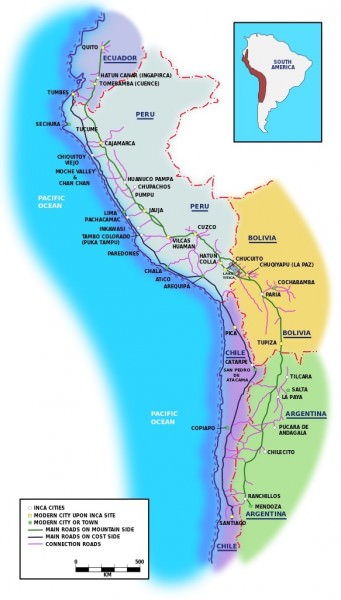
Inca Road System
Generally, campaigns lasted several months and troops needed feeding and shelter. Food and arms were available from the Inca storehouses, the qollqa, which dotted the countryside. To ease the burden on local communities, they were warned beforehand that the army was on its way and the troops moved in staggered groups so as not to all be in the same place at the same time as they marched to the battlefield. Further, any local looting by soldiers was punishable by death.
FORTRESSES
As the empire expanded and so became ever more taxing to police, the Incas were obliged to maintain a permanent presence in the territory they conquered. This necessitated the construction of fortresses, establishing garrisons, and fortifying borders.Forts were typically built at strategic passes and routes likely to be used by invaders in the border areas, especially in the area around Quito where the remains of 37 Inca forts have been identified.
As Andean warfare did not include explosives, large projectiles, or siege engines, fortresses were often simple affairs consisting of a walled enclosure built on a hilltop. They could not shelter a large number of soldiers indefinitely, troops usually slept in tents when not under attack. Walls were built in concentric circles but also included sharp bends to increase the angles from which to fire sling stones on attacking forces. Sometimes extra protection was provided by a moat, revetments, and gates with multiple and offset doorways.
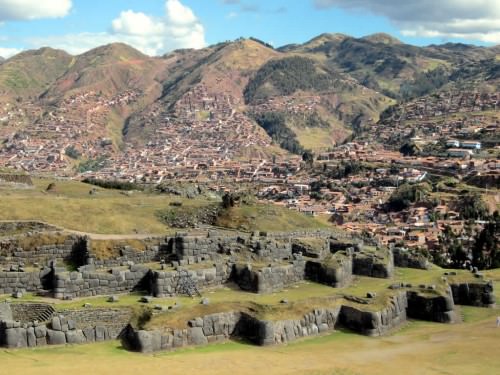
Sacsahuaman
VICTORY & DEFEAT
To the victors go the spoils and the coffers of the Inca king were enriched by war -booty. Those soldiers who had displayed great valour were given rewards depending on their status. These prizes included land, the right to sit with the king, prestigious administrative positions, gold and silver breastplates, fine clothes, captured women, weapons, and livestock. Defeated enemies were taken as captives to Cuzco and paraded before the people, much like in a Roman Triumph, with the Inca king ceremoniously stamping on the head of his defeated counterpart. Some leaders would be sacrificed and particularly hated foes had their skulls made into ornate drinking cups and their skins made into drums. The Incas also captured the sacred objects of a conquered people, symbolically imprisoning them in the Coricancha complex at Cuzco to ensure compliance from the population.
The Incas seem not to have recorded the defeats they suffered, although given their superior discipline and numbers any setbacks were likely only temporarily. The Incas did, of course, meet more than their match when the Europeans arrived with their cavalry and firearms. Their fall was not sudden, though. After initial dramatic defeats and the loss of their king, the Inca actually won some battles and resisted the superior armed invaders for another 50 years. The Spanish would ultimately be victorious but they would also find out exactly how difficult it was to maintain control over a huge empire encompassing all kinds of terrain and hundreds of different cultures spread over thousands of square kilometres.
Jason & the Argonauts › Antique Origins
Ancient Civilizations
The pan - Hellenic mythological hero Jason was famed for his expedition with the Argonauts in search of the Golden Fleece aboard the ship Argo, one of the most popular and enduring legends of Greek mythology.
JASON'S YOUTH
Jason was believed to have been educated by the wise centaur Cheiron in the forests of Mount Pelion. He had been placed under the centaur's care by his father Aison whose younger brother Pelias had usurped the throne of Iolkos in Thessaly. When he reached manhood, Jason participated in the celebrated hunt for the Kalydonian Boar which involved many Greek heroes such as Theseus, the Dioskouroi, Atalanta, and Meleager. This huge creature terrorized the city of Kalydon and the surrounding area in Aetolia, having been sent by the goddess Artemis in order to punish Oineus, Meleager's father, for his impiety in not sacrificing to the goddess.
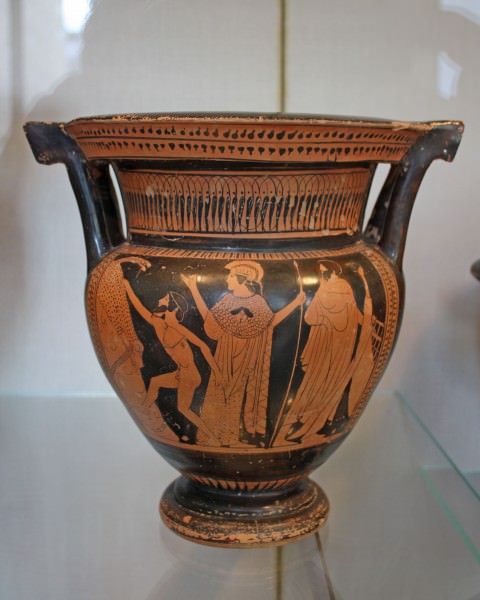
Attic Column-Krater
At the age of 20, Jason finally returned to Iolkos to claim his kingdom. On his return journey Jason somehow lost one of his sandals and when he re-entered the city, Pelias saw him and recalled an oracle some years before which had declared that Pelias would lose his life at the hands of a one-sandaled man. Identifying Jason as the oracle's man, he decided to send the hero on an impossibly difficult and probably fatal expedition to bring the fabled Golden Fleece to Iolkos.
THE GOLDEN FLEECE
The Golden Fleece came from a winged ram originally belonging to the god Hermes. The ram was sent by the goddess Nephele to rescue her children Phrixos and Helle from being sacrificed after Ino, their jealous step-mother, turned the people of Thebes against them. Saved just in time, the ram flew off over the sea with Phrixos and Helle. Unfortunately, during the flight the latter fell off the ram into the sea and the place she landed - the modern straits of the Dardanelles - was thereafter called the Hellespont. Phrixos, however, was safely taken to Kolchis on the Black Sea and in thanks to the gods, he promptly sacrificed the ram and placed its golden fleece in the sacred grove of the god Ares where a fearsome serpent was set to guard it.
JASON WAS A FAVOURITE WITH THE GODDESS ATHENA & IT WAS SHE WHO HAD ARGO BUILD A STRONG FAST BOAT TO TAKE THE HERO ACROSS THE SEAS TO KOLCHIS.
THE ARGO
Jason was a favourite with the goddess Athena and it was she who gave the first help to the expedition by having the great craftsman Argo build a strong fast boat to take the hero across the seas to Kolchis. The ship, reportedly the first Greek long ship, was named after its maker and even contained a plank of sacred wood with the power of speech, taken from the sanctuary of Zeus at Dodona. The Argo could carry 50 oarsmen and Jason filled the boat with an all-star crew of Greek heroes. Among the more famous were Hercules from Boeotia, the Dioskouroi twins from Sparta, Meleager from Kalydon, Peleus from Thessaly, Amphiaraos from Argos, Kalais and Zetes the sons of Boreas (the North Wind), and Orpheus from Thrace.
On their voyage to Kolchis the Argonauts had many adventures. One of the more notable was the rescue of Phineus from the Harpies at Salmydessos in Thrace. These terrible winged creatures had been sent by Zeus to torment the blind Phineus as punishment for blinding his own sons on the advice of their scheming step-mother. Zetes and Kalais, themselves winged, chased away or killed the Harpies thus earning the gratitude of Phineus who gave them favourable winds and advice on the best route to Kolchis. Other diversions occurred on the island of Lemnos where the female inhabitants sought to ensnare the heroes, on the island of the Doliones where they were attacked by savage giants, and on the island of the Mysians where Hercules was lost to the expedition as he searched for his lover Hylas, taken by the water nymphs.
KOLCHIS & KING AIETES
On finally reaching Kolchis, Aietes the king, perhaps understandably, would not hand over the fleece to Jason without a struggle. Instead, he promised Jason the fleece only if he performed some particularly difficult and dangerous tasks. These were to plough a field using two fire-breathing bulls and to sow the teeth of a serpent in the field, and then fight the giants which sprang up from the magical teeth. Fortunately, Jason was assisted by Medea, the daughter of Aietes. Once again, Athena had intervened and sent Eros to make Medea fall in love with the hero. Medea was knowledgeable in magic, and she gave Jason a magic lotion to protect him from the fire-breathing bulls and advised him to throw a stone amongst the giants so that they would fight each other.
Despite successfully completing the tasks, Aietes still refused to give Jason the fleece and even attempted to burn the Argo.However, Medea showed Jason the location of the sacred grove and gave him another potion to drug the serpent that guarded the Golden Fleece. Taking the fleece back to the Argo, Jason was pursued by the king's soldiers but Medea delayed them (even killing her brother Apsyrtus in the process) and she fled Kolchis with the heroes.
THE VOYAGE HOME
The voyage back home to Iolkos was as protracted as the voyage out and the heroes once more had many adventures. A notable episode is the encounter with Talos, the bronze man given to King Minos by Hephaistos, and who ran around the island of Crete three times each day keeping guard. Talos tried to prevent the Argonauts from landing and so incurred the wrath of Medea who brought his downfall with one of her magic potions.
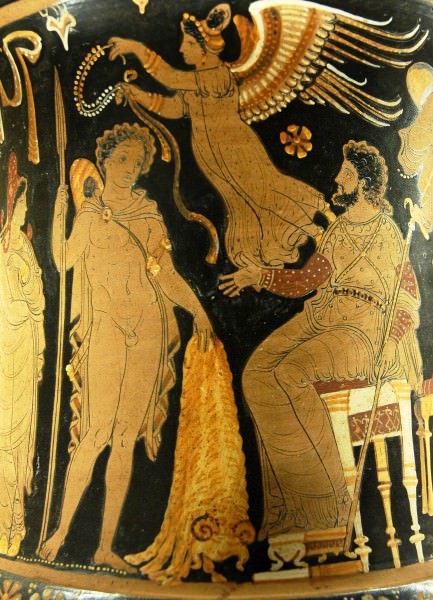
Jason brings Pelias the Golden Fleece
On the heroes' triumphant return to Iolkos, despite being given the Golden Fleece, Pelias refused to give up his throne, and it was discovered that Pelias had even conspired to kill Jason's father, Aison, whilst the hero had been away. Medea then made another magic potion, this time to convince the daughters of Pelias that if they cut up their father and boiled him in the potion, he would gain everlasting youth. This they did and, of course, it was the end of Pelias, but Jason did not become king, instead, he established Pelias' son Akastos as ruler. Jason, after marrying Medea, left to settle in Corinth which had been inherited by Aietes from his father Helios. The couple had three sons and lived happily for ten years until Jason became captivated by the charms of Glauke, daughter of Kreon, the king of Corinth. In jealous revenge, Medea killed both Glauke (with a poisoned robe and crown) and her own children and fled to Athens, in some accounts in a flying chariot pulled by dragons. This tragic end to the myth is the subject of Euripides tragedy Medea.
LINKS WITH REALITY
The myth of Jason and the Golden Fleece may have been an explanation of early Greek expeditions into the East around the 13th century BCE, when the Mycenaean civilization was at its peak. The tale also has similarities to a Hittite myth involving a fleece and the god Telipinu. A third connection with the East is the historical evidence suggesting that the area of Kolchis near the Caucasus Mountains was one rich in gold, often panned from rivers using sheepskins.
THE MYTH IN GREEK ART
The myths involving Jason were popular subjects in ancient Greek art. The antiquity of the subject is demonstrated by a scene on a Corinthian alabastron as early as the 7th century BCE. The earliest depiction of the Argo comes from a fragmentary metope from the Treasury of the Sicyonians at Delphi, c. 570 BCE. The presence of various scenes from the myths on Attic, Laconian, Corinthian, Chalcidian, and Southern Italian pottery throughout the 5th and 6th centuries BCE and the re-telling of the tale in the Argonautica by Apollonius of Rhodes in the 3rd century BCE are evidence of the far-reaching and long-lasting appeal of this truly pan-Hellenic hero.
LICENSE:
Article based on information obtained from these sources:with permission from the Website Ancient History Encyclopedia
Content is available under License Creative Commons: Attribution-NonCommercial-ShareAlike 3.0 Unported. CC-BY-NC-SA License